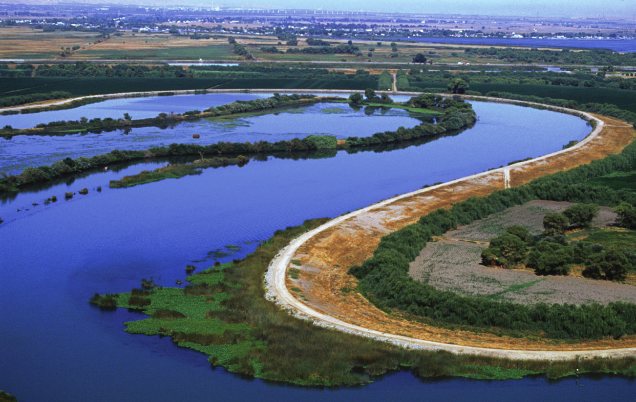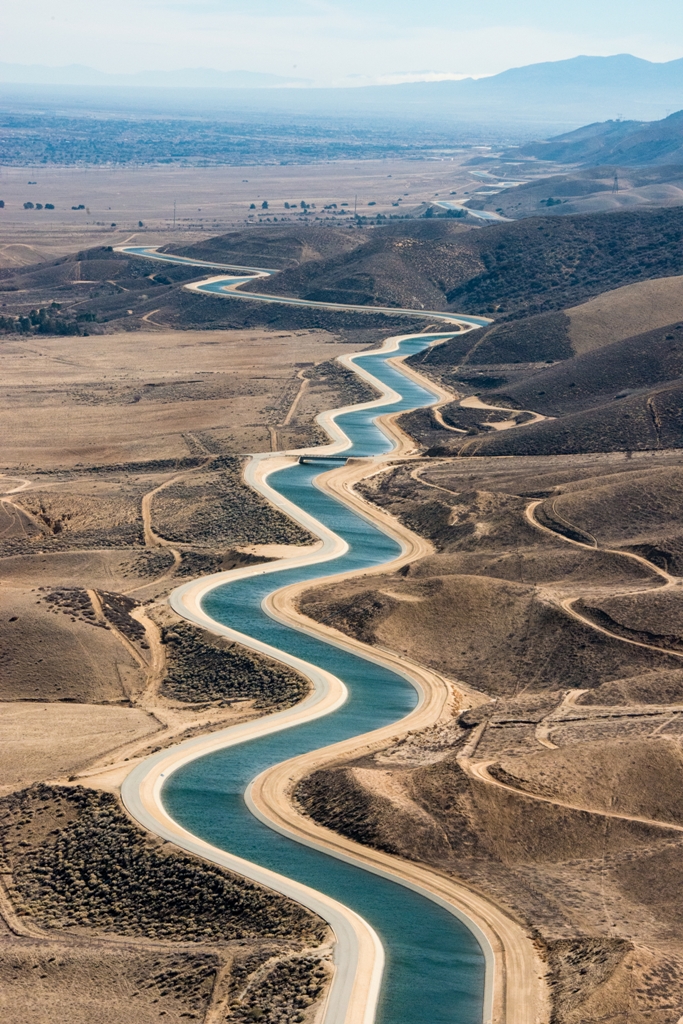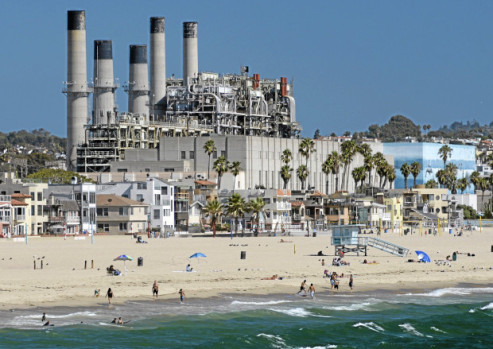
California Bay Delta water (Photo: USGS.gov)
Objections to Desalination are Shopworn, Discredited Cliches
Nothing gets built anymore in California, but Gov. Gavin Newsom is fighting to get this plant built
By Edward Ring, March 7, 2021 2:11 am
Anyone who still thinks that the Huntington Beach desalination plant poses a significant threat to the environment should ask themselves: Why would Governor Gavin Newsom, a Democrat who depends on donors that never saw an environmentalist overreach they didn’t like, be going out on a limb to support this project?
The reason is simple. Newsom’s talked with all the experts, he’s weighed the costs and benefits, and he supports desalination. An article earlier this week discussing the progress this project has just made towards finally getting built has triggered several in-depth criticisms, which deserve a response. But before all that, consider Exhibit A: Gavin Newsom is fighting to get this plant built.
It’s about time. Nothing gets built anymore in California, thanks to a powerful partnership between environmentalist litigators and anti-tax libertarians. Both of these special interests, both wearing ideological blinders, oppose anything that uses public funds to make so much as a scratch in the ground. From the left and from the right, they’ve combined forces to leave California’s infrastructure in tatters.
Other special interests benefit from this game. Back in a saner, less corrupt era, California’s public infrastructure was often built and maintained out of operating funds. Now bonds are even issued for “deferred maintenance,” i.e., we’re borrowing money just to maintain what we’ve got, and all that money in the state and local government budgets that used to pay for infrastructure is now fed into the insatiable maw called CalPERS, CalSTRS, and the rest of the public employee pension funds. Bond underwriters make more money, and as for pension reform, what’s that?
California’s tech sector, more omnipotent these days than ever, also loves the scarcity that comes from a neglected infrastructure. Less water? Less electricity? Better buy our gadgets. Along with the manufacturers of every not-so-durable appliance, the nerd billionaire lobby puts chips into everything from the toilet to the coffeemaker, to “help” us consume less. Don’t call it rationing, call it saving the planet. Meanwhile we’ll get rich selling the chips, and richer still selling the data the chips collect.
But Newsom knows all this, and these special interests are his constituency. So why is he defying them? Because California has been hit with mega-droughts periodically for thousands of years. It is a risk irrespective of modern climate change. And this time, that drought will find 30 million Californians living on an arid coastline, hundreds of miles from whatever shrunken supply of water might still be available. Or maybe it will be an earthquake, or a terrorist attack, at any point along California’s hundreds of miles of aqueducts and pumping stations, that abruptly halts the water being moved into California’s coastal cities.
What part of this do opponents of the Huntington Beach desalination plant fail to understand?
Q&A Regarding Desalination in Huntington Beach
While the questions that appeared in the comments section of the previous report on the proposed desalination plant were thoughtfully written and brought up important points, when researching the topic further it quickly becomes evident they are the same points that have been brought up, and thoroughly addressed, again and again. Poseidon has spent nearly 20 years and $100 million so far developing this project. It will be one of the most modern, environmentally sensitive desalination plants ever built.
To help answer some of the questions raised, I contacted Scott Maloni, a vice president at Poseidon Water. Much of what is to follow came from him. Here are some of the objections raised, and the responses:
1 – The plant is being built adjacent to a superfund site.
Incorrect. The desal plant is not adjacent to the Ascon superfund site, it’s separated by a flood control channel and several parcels of land including a parcel owned by Shopoff Development and approved by the City of Huntington Beach last month for a mixed-use development including an eco-lodge. No aspect of the desal project (treatment plant or water delivery pipelines) will be affected by the Ascon site or vice-versa. The Potential impacts on and from the Ascon landfill were studied in the City of Huntington Beach’s 2010 EIR. Opponents attempted to bring up this this issue again in the Santa Ana Regional Water Quality Control Board process last year and the water board addressed and dismissed the concern as lacking merit. Finally, the Ascon site is in the process of being remediated and this process will be finished before the desalination plant commences construction.
2 – Desalinated water is contaminated with boron, which is a by-product of the desalination process.
Ocean water has higher concentrations of boron but it is removed by the reverse osmosis process. Boron isn’t a public health and safety concern, high concentrations of boron can affect the vitality of certain crops and ornamental flowers. Irvine Ranch Water District (IRWD) raised a concern 6 years ago that higher boron levels in desalinated water could affect their ability to operate recycling plants because the byproduct of their plants might exceed regulatory requirements. The Huntington Beach project’s reverse osmosis system is designed to get the boron down to 0.75-1.0 mg/l, which fully addresses IRWD’s concerns.
3 – The Orange County Water District has said they will just store that water in their aquifers, thereby contaminating.
Desalinated water will not contaminate the groundwater basin. The Orange County Water District (OCWD) puts 100 million gallons of treated wastewater into the groundwater basin every day using the same treatment process that the Huntington Beach desalination plant will use, reverse osmosis. OCWD has not made a decision whether to deliver the desalinated water to cities and water agencies directly through the potable water pipeline system or to inject some or all of the desalinated water into the groundwater basin. The groundwater basin is simply a means of distribution. Putting desalinated water into the groundwater basis allows cities throughout Orange County to pump more groundwater and rely less on imported water.
4 – Marine life will be harmed both by dead zones at the point of brine disposal and destruction of larvae and plankton from the open intake pipes.
The facility is required by state regulations to incorporate the best available and feasible seawater intake and discharge technologies to minimize the intake and mortality of all forms of marine life. The plant will have 1-MM wedgewire screens on the intake with a through screen velocity of less than 0.5 feet per second and a brine diffuser on the outfall. The Santa Ana Regional Water Quality Control Board permit published last month and scheduled for approval in April finds that the project with these technologies complies with all state marine life protection regulations. There will be no “dead zone” from the discharge. Salinity from the discharge will be 35.5 pt (2 ppt above ambient salinity) at an average radius of 79 feet from the point of discharge.
Finally, despite the fact that numerous state agencies have found the unavoidable entrainment of microscopic fish larvae to be insignificant, Poseidon must still mitigate for these impacts as a condition of the Regional Board permit. Poseidon will preserve, restore and create 112 acres of coastal habitat to offset these larval fish impacts including 4 projects in the Bolsa Chica wetlands and a 5th project in the form of a 41-acre artificial reef off the coast of Palos Verdes.
The imported water that the desalinated water will replace is purported to have negative environmental impacts. By offsetting this imported water and over-mitigating for its local impacts the Huntington Beach project will be a net environmental benefit.
5 – Rate payers ultimately foot the bill. Poseidon applied to the State’s California Debt Limit Allocation Committee (CDLAC), a little known agency to ask for $1.1B out of their housing allocation budget to build a plant that will supposedly cost $1.2B.
The Huntington Beach project was invited by California Debt Limit Allocation Committee to apply for PAB bond allocation. But they have not yet applied for financing from CDLAC. But these financing sources take pressure off ratepayers. In 2012, the Carlsbad desalination plant was financed, in part, with Private Activity Bonds (PABs) issued through CDLAC. PABs are tax exempt bonds issued to every state by the federal government in order to incentivize private investment in public-serving infrastructure like housing, water and transportation. The bonds are non-recourse to the state of California and the state and feds have no financial liability. The tax-exempt nature allows for lower interest rates which then accrue to the benefit of the water ratepayer in the form of lower water rates from the desal plant.
Many of the libertarian tax fighters opposed to the desalination plant in Huntington Beach either don’t understand the principles behind a public-private partnership or intentionally ignore the benefits. As the private partner, Poseidon assumes all the financial risk for developing, building and operating their plants. The public agency partners (i.e., San Diego County Water Authority and Orange County Water District) only pay for water that meets contractual specifications for quantity, quality, reliability and price. These contracts include a fixed price for water negotiated and executed before the plant is built. If the plant takes longer to build and comes in over budget, Poseidon absorbs those losses. If the plant can’t operate for whatever reason and we can’t deliver the contacted water, then Poseidon absorbs those financial losses.
The Carlsbad desalination plant has never been shut down due to permit violations. The plant has been temporarily shut down by the plant operator the Israeli Desal Engineers (IDE) on a number of occasions over its 5-year operating history to fix routine mechanical issues or for environmental issues affecting the quality of the source water from the ocean like algal blooms. Under the contract with the SDCWA, if Poseidon fails to cure the shutdowns in a specified period and/or cannot deliver the water they are obligated to deliver then they have to pay SDCWA so they can buy water to replace what they could not get from Poseidon. This is a unique arrangement in the water world and benefits the public agency and its ratepayers. At the end of the water purchase contract the public agency owns the desalination plant, so they are not just paying water they are inheriting an infrastructure asset.
Finally, it’s interesting that the term NIMBY is so readily trotted out by environmentalists when it suits them, but ignored when it does not. If you oppose high density housing, you’re a NIMBY. If you oppose new housing on California’s abundant open land, you’re not. If you oppose a solar farm that blankets thousands of acres with a blistering heat island, or a wind farm that blankets tens of thousands of acres with an avian slaughterhouse, you’re a NIMBY. If you oppose a desalination plant that will prevent people in Southern California from dying of thirst when the rains don’t fall or the pumps fail, you’re not. Fascinating.
- Ringside: Will the Delta Pumps Operate at Capacity this Winter? - December 18, 2025
- Ringside: Will Advocates for More Water Supply Projects Find Unity? - December 11, 2025
- Ringside: EVs and California’s Future Demand for Electricity - December 4, 2025





Thank you Ed Ring for publishing this comprehensive article…
It has helped me realize that CA is indeed a lost cause and probably always has been…
The other complicating factor to this decision is the recent LA Times article describing the decades of offshore dumping of toxic products in Santa Monica Bay that has killed off much of the sea life that I remember from my childhood…
There used to be plentiful shells on the beach from Santa Monica to Zuma and the water was a beautiful blue, not the brownish green that is is now….
El Lay has treated the ocean as its personal dumping ground for years ( drainage system for the diminishing rains) and this is the water that will be desalinated…
Seismic risk to CA aqueduct… Terrorist threat…
All adds up to vacation destination to thaw out occasionally….
Byeeee…..
I’m a 66 year old native of So. Cal. and this plant has been kicking around for years, my feeling is get it done! We need Nukes too and THEY will desalinate water almost as a byproduct but in Today’s FLASH Report there was a column by Steve Lopez at the LA Times, the NIMBY’s are at it again. He says we don’t need it, Really? Here’s his link: https://www.latimes.com/california/story/2021-03-06/desalination-plant-poseidon-newsom-environment
So why does everyone TALK about rainwater capture and nobody DOES anything about it except pass our mosquito-larvae breeding rainwater barrels that evaporate in a week???
Dams? Not allowed anymore.
By the time they get it built we won’t need it the world will have ended by then
Where will the power come from to operate this energy-sucking plant? A Utah coal fired generator?
And speaking of water for Californians, how’s the Sites Reservoir project coming along?
Thanks for the clarification. So, if I understand it, OCWD will be the primary customer and intends to buy and recharge groundwater resources via their spreading grounds when it’s cost-effective vs. paying for Metropolitan’s wholesale rates, getting OCWD a bit of flexibility and independence from Metropolitan. The Private Activity Bonds seem well-allocated – this is an old legacy from TEFRA that allows Poseidon to gain favorable financing. Nothing wrong there – it’s in the public interest, but Poseidon is still bearing the investor risk and those tax credits are going to be allocated anyway so the “Libertarian” (they aren’t) issues are null. This means the taxpayers aren’t holding the bag if it’s a boondoggle. The environmental concerns strike me as suitably mitigated. Looks like a good project.
There are probably no acceptable water sources for human consumption according to the “environmentalists”. You can’t use surface water because of dams and fish. You can’t use wells because of the ground water levels and you probably can’t collect rain water because it would take water away from “nature”.
The only thing left is recycled sewage which I encourage the Sierra Club to make their official refreshing drink.
I believe the officially sanctioned Sierra Club description is “toilet to tap”…